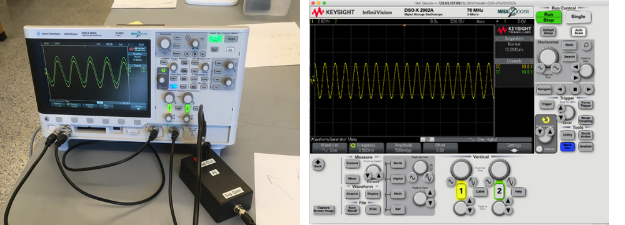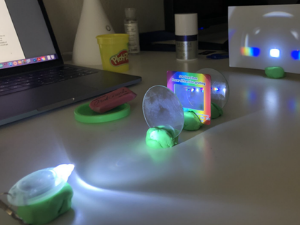Bringing Hands-on Physics Labs Home

Cal Poly physics faculty make significant contributions to fundamental and applied knowledge about the world and the universe. Undergraduates explore, experiment, publish and present alongside their faculty mentors, creating a vibrant learning environment. Below you'll find a sampling of what students and faculty have done and discovered in the last year.
Electronics and Instrumentation
with Matt Moelter
I taught Physics 206 Electronics and Instrumentation in winter quarter, and the students did the labs at home.

From online sources students purchased a digital multimeter, an electronics kit (wires, breadboard/power supply, resistors, capacitors, diodes, transistors, etc.) and an EspoTek Labrador oscilloscope/signal generator that plugs into a USB port. A few weeks into the quarter students were sent or picked up from the Baker Center some additional components (555 timer, 741 op amp, counter, decoder, 7 segment display).

In addition, the department purchased modules to make oscilloscopes we already owned internet accessible. This allowed me to set up circuits in the Baker Center that students could investigate remotely while controlling the actual signal generator and oscilloscope via a web browser.

We did almost all the experiments usually done in person: intro to DC circuits; oscilloscope basics (esp. triggering); “unknown” circuit characterization; high/low/bandpass/notch filters; I-V characteristics of diodes; transistor switching and amplification; op-amp followers, (non)inverting amplifiers, relaxation oscillators; generating digital pulses with counting and display.
The students seemed to appreciate handling equipment. They were enthusiastic and handled the challenges well. You can imagine them holding their breadboard up to the shared Zoom screen and me saying, “Which row is pin 6?” or “I think the second orange wire on your left should be one hole to the right.”
Optics
with John Sharpe

We put together a suite of experiments for Physics 323 Optics that could be implemented in the students’ own homes. The experiments included optical imaging, diffraction, interference and polarization optics. Many components were off-the-shelf, and we also put together rotation mounts, laser power supplies and photodetector systems. The photograph shows one of the student's experiments where light from a white LED is collimated by the first lens and the grating spectrum observed in the back-focal plane of the second lens.
Quantum Lab
with Tom Bensky
I taught Physics 341 Quantum Lab virtually. This is one of our department's core advanced labs for physics majors. It was important for me that the students get some hands-on work, even from home in a virtual class. So, I had them buy some electronics parts which would allow them to build circuits at home to study some physical phenomena.
It went well overall, but just like an in-person lab, sometimes things just don't work. In this case, the circuit involved coaxing a 12.1 Volt Zener diode into fits and spurts of conduction with a suitable reverse bias voltage of about 11.8 volts. The statistics of when conduction occurs is of interest, and data was captured using an Arduino.
One student simply could not get their circuit to work, no matter what he tried. So, using Zoom we both cleared our breadboards and rebuilt our circuits together from scratch, piece by piece. In the picture (see top of page), you can see my triage setup: an iPhone mounted on a tripod showing a livestream of my workspace. We were also exchanging pictures and texts using Slack.
In the end the student's circuit still didn't work and my home office was a total mess. So, I pulled some parts off my circuit and mailed them to him. It ended up working, and the student got their data. A happy ending after all!
